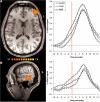From moral to legal judgment: the influence of normative context in lawyers and other academics
- PMID: 20194515
- PMCID: PMC3023080
- DOI: 10.1093/scan/nsq010
From moral to legal judgment: the influence of normative context in lawyers and other academics
Abstract
Various kinds of normative judgments are an integral part of everyday life. We extended the scrutiny of social cognitive neuroscience into the domain of legal decisions, investigating two groups, lawyers and other academics, during moral and legal decision-making. While we found activation of brain areas comprising the so-called 'moral brain' in both conditions, there was stronger activation in the left dorsolateral prefrontal cortex and middle temporal gyrus particularly when subjects made legal decisions, suggesting that these were made in respect to more explicit rules and demanded more complex semantic processing. Comparing both groups, our data show that behaviorally lawyers conceived themselves as emotionally less involved during normative decision-making in general. A group × condition interaction in the dorsal anterior cingulate cortex suggests a modulation of normative decision-making by attention based on subjects' normative expertise.
Figures




Similar articles
-
Individual differences in moral judgment competence influence neural correlates of socio-normative judgments.Soc Cogn Affect Neurosci. 2008 Mar;3(1):33-46. doi: 10.1093/scan/nsm037. Epub 2007 Dec 3. Soc Cogn Affect Neurosci. 2008. PMID: 19015093 Free PMC article.
-
Individual differences in moral judgment competence are related to activity of the prefrontal cortex when attributing blame to evil intention.Soc Neurosci. 2016;11(4):438-48. doi: 10.1080/17470919.2015.1093960. Epub 2015 Nov 16. Soc Neurosci. 2016. PMID: 26569419
-
Is morality unified? Evidence that distinct neural systems underlie moral judgments of harm, dishonesty, and disgust.J Cogn Neurosci. 2011 Oct;23(10):3162-80. doi: 10.1162/jocn_a_00017. Epub 2011 Mar 31. J Cogn Neurosci. 2011. PMID: 21452951
-
Investigating emotion in moral cognition: a review of evidence from functional neuroimaging and neuropsychology.Br Med Bull. 2007;84:69-79. doi: 10.1093/bmb/ldm031. Epub 2007 Nov 20. Br Med Bull. 2007. PMID: 18029385 Review.
-
[Orbitofrontal cortex and morality].Brain Nerve. 2012 Oct;64(10):1121-9. Brain Nerve. 2012. PMID: 23037603 Review. Japanese.
Cited by
-
Neural correlates of moral reasoning in autism spectrum disorder.Soc Cogn Affect Neurosci. 2013 Aug;8(6):702-10. doi: 10.1093/scan/nss051. Epub 2012 May 7. Soc Cogn Affect Neurosci. 2013. PMID: 22569187 Free PMC article.
-
Explicit and implicit markers of fairness preeminence in criminal judges.Sci Rep. 2021 Sep 2;11(1):17599. doi: 10.1038/s41598-021-96962-9. Sci Rep. 2021. PMID: 34475479 Free PMC article.
-
From Neuroscience to Law: Bridging the Gap.Front Psychol. 2020 Oct 22;11:1862. doi: 10.3389/fpsyg.2020.01862. eCollection 2020. Front Psychol. 2020. PMID: 33192747 Free PMC article.
-
Neurofunctional correlates of ethical, food-related decision-making.PLoS One. 2015 Apr 1;10(4):e0120541. doi: 10.1371/journal.pone.0120541. eCollection 2015. PLoS One. 2015. PMID: 25830288 Free PMC article.
-
Law and neuroscience.J Neurosci. 2013 Nov 6;33(45):17624-30. doi: 10.1523/JNEUROSCI.3254-13.2013. J Neurosci. 2013. PMID: 24198354 Free PMC article. Review. No abstract available.
References
-
- Amodio DM, Frith CD. Meeting of minds: the medial frontal cortex and social cognition. Nature Reviews Neuroscience. 2006;7(4):268–77. - PubMed
-
- Benjamini Y, Hochberg Y. Controlling the false discovery rate: a practical and powerful approach to multiple testing. Journal of the Royal Statistical Society Series B: Methodological. 1995;57(1):289–300.
-
- Blair RJR. The amygdala and ventromedial prefrontal cortex in morality and psychopathy. Trends in Cognitive Sciences. 2007;11(9):387–92. - PubMed
-
- Blair J. Cognitive neuroscience of psychopathy. Journal of Neurology Neurosurgery and Psychiatry. 2008;79(8):968–978.
Publication types
MeSH terms
Substances
LinkOut - more resources
Full Text Sources
Molecular Biology Databases

